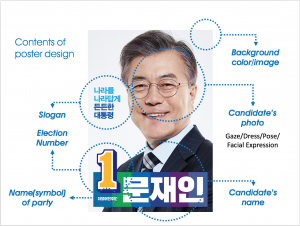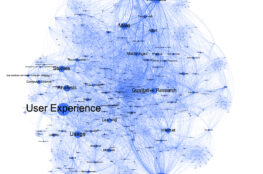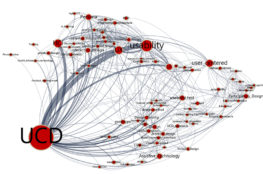Analyzing Poster designs for the New President Election in South Korea
Abstract
This paper analyzes the poster designs of the top five new president candidates in South Korea. For visual analysis, I use two methodologies – content analysis and social semiotic visual analysis – these methods come from a book, Handbook of Visual Analysis, is written by Van Leeuwen, Theo, and Jewitt, Carey in 2007. Through the content analysis, I compare the visual contents of the five posters. With social semiotic visual analysis, I use google trend to know how peoples’ interest per each candidate is shifted.
Keywords: Visual, Analysis, Poster, Politic, Election, Interest, South Korea
Introduction
In Handbook of Visual Analysis (Van Leeuwen, Theo, and Jewitt, Carey. 2007), the authors explain several different methods for visual analyzing such as content analysis, visual anthropology, cultural study, semiotics and iconography, a therapeutic perspective, visual meaning, an ethnomethodologically approach, and analyzing film and TV. For this study, I select the content analysis and the social semiotic approach to analyze the poster designs of the top five president election candidates. Through this analysis, I’d like to know how they used visual contents for the poster design and how the posters work for increasing peoples’ interest.

Content analysis

Content analysis is a systematic, observational method used for testing hypotheses about the ways in which the media represent people, events, situations, and so on. It allows quantification of samples of observable content classified into distinct categories. It does not analyze individual images or individual visual texts. Instead, it allows a description of fields of visual representation by describing the constituents of one or more defined areas of representation, periods or types of images. To observe and quantify categories of content it is first necessary to define relevant variables of representation and/or salience. Then, on each variable, values can be distinguished to yield the categories of content that are to be observed and quantified. A content variable is any such dimension (size, color, range, position on a page or in a new bulletin); or any range of options of a similar type which could be substituted for each other. In content analysis, a variable refers to aspects of how something is represented, no to ‘reality’. A variable consists of what we will call value. These are elements that are of the same logical kind. Contents analysis begins with the definition of relevant variables and of the values on each. For my study about the poster designs, I analyze the contents of the poster design – portrait, name, number, party name or symbol, and background color – as a category for variables¬¬¬. Once I set these categories, I observed poster designs to find variables and values per each content. Under the gaze category, I set two different variables such as facing front and looking above. For the gesture category, I put siting diagonally and facing the front as a variable. In the dress category, there are suits with a tie, suits without a tie, and shirts on with tie for each variable. For the type of photo shoot, I write down a bust shot, waist shoot, and close-up shot. Under the facial expression, I put two variables such as a light smile and a bright smile. I set the confidence victorious and friendly as a variable for the moods. For the position of a candidate’s name, I set the bottom and top as a variable. Under the position of the slogan, I put the left side, right side, and on the picture. In the position of part name or symbol, bottom-left, top-left, top-right, and on the picture, are determined as a variable. Yellow, Red, and blue set as a variable for the color of the number category. Under the color tone, I put bright and dark as a variable. For the background color, there are white, colored, and picture as a variable. To get more detailed quantitative analysis, percentage analysis is used per each variable and value. For the gaze, 60% of candidates are facing front, and 40% are looking above. 60% of candidates are sitting diagonally, and 40% are facing front under gesture position. In the dress category, all of them are suit up, but 40% are with a tie, another 40% are without a tie, and 20% are just shirts on with tie. 60% of posters use a bust shot of a candidate, 20% use waist shot, and another 20% use close-up-shot. All of the candidates smile but 40% are light smiles, and 60% are bright smiles with showing their teeth. For overall mood, 40% of candidates look like confidence, another 40% look like friendly, and 20% look like victorious. Position of the candidate’s name, 80% put the name on the bottom of the poster, 20% put the name on the top. Under the position of the slogan, 40% put the slogan on the left side, another 40% put it on the right side, and 20% put it on the picture, but the position of the slogan depends on the gaze or candidate’s sitting position. In the position of party name or symbol, 40% put it on the top-left, others put it on the bottom-left, top-right, or on the picture. For the color of the number, 60% use yellow, 20% use Red, and another 20% use blue, these colors came from their party color. Under the color tone, 80% use bright color tones, and 20% use dark color tones, and it would be affected by the overall mood of the poster. In the background category, 60% of posters use background colors such as grey, green, and light blue, 20% use a white background and another 20% use blurred pictures for the background. As a conclusion, depending on how they want to look like or how they want to show them up to, the overall mood, portrait styles, and poster layout would be determined.
Social semiotic visual analysis

The author says that there are kinds of ‘rules’ for social semiotic, from laws and mandatory prescriptions to ‘best practice’, the influence of role models, expert advice, common habits, and so on. Two points need to be made social semiotic influence. First, ‘power’, ‘detachment’, ‘involvement’, and so on, are not ‘the’ meaning of these angles. They are an attempt to describe a meaning potential, a field of possible meanings, which need to be activated by the producers and viewers of images. Secondly, symbolic relations are not real relations, and it is precisely this which makes a point of view a semiotic resource. Images can create particular relations between viewers and the world inside the picture frame. In this way, they interact with viewers and suggest the attitude viewers should take towards what is being represented. Through this methodology, I’d like to know how these posters work to get peoples’ interest per each candidate. Thus, I use the google trend with candidates’ name as a keyword. I set a duration for good trend research from Mar 10th, 2017 to April 30th, 2017. The reason why I set the start date as Mar 10th, 2017, is at that time Korean president Park ousted by a court, and new president candidates were nominated by their party. After they were nominated as a new Korean president candidate, peoples’ interest is going up, but after these posters were released there are not a huge shift of people’s interest. Thus, I’m not sure whether these posters work well or not. However, one of these posters, Ahn’s poster, attempted different styles form other candidates, so I use google trend with “Ahn’s poster” as a search keyword. Then, I’ve got a hugely different result related to his poster, as you can see in figure 6. Peoples’ interest in Ahn’s poster was growing up dramatically after release the poster on April 17th, 2017. People googled a lot to time to get some information related to his poster. Therefore, a lot of journalists released news articles about this poster. As a conclusion, I’m not sure other candidates’ posters work well or not, however, Ahn’s poster works well to attract peoples’ attention as a positive or negative.
Future study
To measure the success of the poster design, it is needed to eliminated other influences related to peoples’ interest such as debating or personal issues per each candidate. Therefore, individual surveys of poster design are needed to know only peoples’ interests related to the poster designs.
Reference
Van Leeuwen, Theo, and Jewitt, Carey. Handbook of Visual Analysis. London: SAGE Publications, 2007. Print.



